|
Evolution
of the Riviera - 1965
by Ray Knott #1
Originally published in The Riview Vol. 18, No. 4 May/June
2002
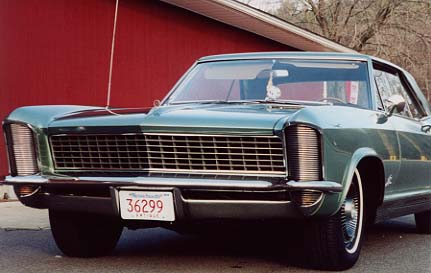
Headlights were hidden in the fenders behind motor operated
clamshells.
|
The first noticeable changes took place in the third year
of the Riviera with hidden headlights and a restyled rear bumper. GM's
chief stylist Bill Mitchell had originally wanted the headlights hidden
in the fenders as shown in the preliminary drawing of the XP-715 project
model. However, the engineering had not been completed in time for the
earlier models. The ribbed clamshells were controlled by a single electric
motor located behind the front bumper, and operated automatically when
the headlights were turned on or off. As much as the hidden headlight
added to the cleaner appearance they also added to frustration if they
didn't work. Most often the problem occurred when the arms out to the
clamshells were not kept lubricated and the motor burnt out. The only
other GM car with the hidden headlight in '65 was the Corvette Sting
Ray, which had a similar motor. |
| Adding to the cleaner look was the removal of the non-functional
side scoops. In the rear, the taillights were moved from the body into
a large one-piece bumper and a Buick Tri-shield emblem covered the trunk
lock. A ribbed rocker panel with a motif similar to the headlight covers
was standard with the optional interiors or it could be ordered separately
for only $26.88. Offered for the first time on the Riviera was the popular
chrome wheel with painted charcoal inserts for $91.38. These wheels
were first introduced on the '64 Wildcat. On April 9th, 1965 Buick announced
to its dealers that an optional vinyl roof would be available on the
Riviera. The roof was offered only in black and would be indicated on
the trim code plate as "#2" As it turned out only 5.8% of
the 65 models were ordered with this option, which listed at $110. |
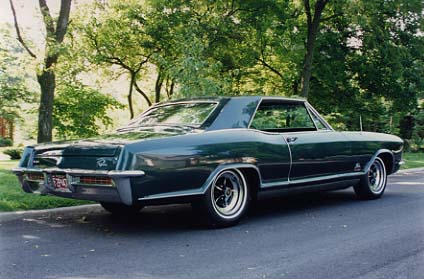
Removal of the side spears and addition of the rocker panel
molding adds to the clean look.
|
| The standard interior seat trim was stitched in a square
pattern much like the earlier models. The standard vinyl interior was
available in white, black, medium blue or saddle. The doors had the
small arm rest and a small patch of wood veneer with a stylized "R"
above the armrest. The dash on all of the 65's had a new textured black
face, with the console covered in wood veneer. The optional Beaumonde
cloth and vinyl interior was available in green, medium blue, black
or fawn, which listed at $96.75. The optional all vinyl interior listed
at $166.63 and was offered in black, saddle and green. It wasn't until
Jan 29th 1965 that Buick made white available in the optional all vinyl
interiors. Once again as in '64 leather was not offered. The optional
interior seats had a unique triangular pattern, unlike the square pattern
used earlier. The interior molding was chromed in the optional interior
not painted as in the standard interior. The doors on the optional interior
were similar to the earlier models with a long armrest and full-length
wood veneer panels. As previously stated the ribbed rocker panel was
also part of the optional interior package. A tilt sheering column became
standard in '65, as did front seat belts. |
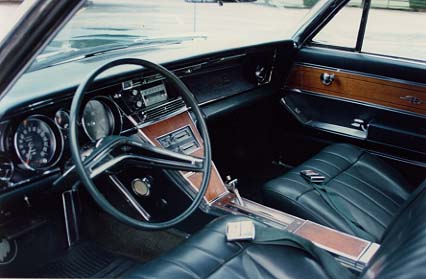
The upgrade interior has a long arm rest and full wood panel.
|
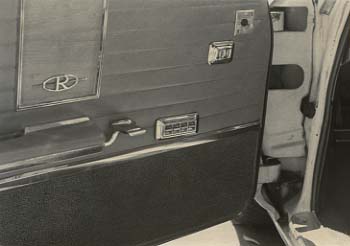
A Standard door panel with a small wood panel and short arm
rest.
|
For reasons unknown Buick reverted back to making
the 325 hp "Wildcat 445" 401ci engine as standard equipment,
whereas in '64 the 425 ci was standard. The 401 ci, code "LT"
was put in 28, 467 Rivieras and had a single 4 bbl carburetor. The
optional 340 hp 425 ci "Wildcat 465" code "LW"
was installed in only 2,311 of the '65 Rivieras at an extra cost
of $48. A third option was the dual 4 bbl carburetor "Super
Wildcat" rated at 360 hp 425 ci, code "LX" for only
$188 of which 3,808 were installed.
|
| The Gran Sport package, which listed at $306.38 made its
debut two months after production, started on the 65 models. It should
be noted that the Gran Sport was only an option, not a separate model,
therefore there were no indicators in the vin or on the trim code plate.
Details on how to identify a 1965 are covered in Volume 17-3 of the
Riview, pages 13 & 14. It is said that the Gran Sport was offered
to keep up with the increasing popularity of muscle cars. In addition
to the "LX" 425 dual 4 bbl engine, the Gran Sport option also
included a modified exhaust, Positraction differential (3.42 ratio),
modified transmission, 8.45x15 tires and a special wheel cover. The
wheel cover was basically a standard hub cap with a spinner attached..
A total of 3,354 Gran Sports were manufactured, which meant that only
454 of the "LX" engines were put into non Gran Sports. A separate
handling package with heavy-duty suspension and quicker steering was
available for every model. All the Gran Sports had identifying emblems
on the fenders under the Riviera script and on the rear deck. Initially
the emblems measured only 3x 1-½ inches and were put under the
Riviera script on the rear deck. In mid December of 1964 the emblems
were enlarged to 5 ¾ x 1 5/16 and the rear emblem was moved to
the left side |
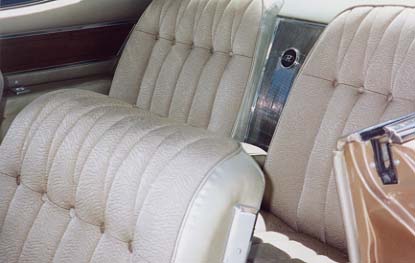
An example of the optional seat pattern.
|
Arctic White was the most popular color in '65, with 14.3 % produced, followed
by Astro Blue at 9.8% and Silver Cloud at 9.2%. Sahara Mist, Verde Green
and Seaform Green all came in at a little over 8%. The least popular colors
were Flame Red at 3.1%, Bamboo Cream at 2.7% and Midnight Aqua at 2.5 %
Although Buick sales increase in '65, Riviera sales fell to 34,568, short
of the projected 40,000. The base price of the Riviera rose to $4,408 up
only $23 from the previous year. Even though the Riviera came with many
standard features, many buyers chose from a long list of options. Some of
the most popular options were: Air Conditioning at $430, which was installed
in 69%, Whitewall tires $43.32 (95.6%), remote outside mirror $11.93 (79.7%),
power windows $107.50 (74.2%), tinted glass $43 (67.5%) and a 4 way power
drivers seat $70.95 (55.5%). Some of the least popular and now rare options
were; four note horn $27.95 (13.9%),. cruise control $56.98 (12.6%), simulated
wood steering wheel $53.75 (10.2%), power vent windows $53.75 (9.2%) and
Guide-Matic headlight control $43 (3.4%) and The rarest of all were; less
air conditioning modification $18.28 (.6%), less seat belts $11 (3%) and
less heater/defroster $98 (.1%). Yes, people even paid to remove such basic
standard features.
| Year |
Body |
Total Production |
   |
Engine Size |
HP * |
Carbs |
Produced |
| 1965 |
49447 |
34,586 (Includes 3,354 GS
Option) |
Standard: |
Wildcat 445 |
401 cu. in. V8 |
325 |
1x4bbl |
(28467) |
| |
|
Option: |
Wildcat 465 |
425 cu. In. V8 |
340 |
1x4bbl |
(2311) |
| |
|
Option: |
Super Wildcat |
425 cu. in. V8 |
360 |
2x4bbl |
(3808) |
| |
* Note: Only 454, 2-4 bbl.
engines were installed in cars without the GS Option |
| Year |
Curb Weight
|
Wheelbase  |
Track |
Length  |
Width  |
Height  |
Tire |
| Front |
Rear |
Size |
| 1965 |
4036 |
117 |
63.4 |
59 |
208 |
76.6 |
53 |
8.45x15 |
|



